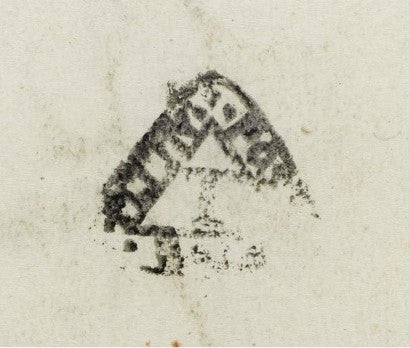Sotheby's London has announced that it will sell a previously unrecorded example of the earliest version of the original Dockwra hand-stamps, the "Murray's Post" stamp, in its English Literature, History, Children's Books and Illustrations Sale on December 15th 2011.
Marking a crucial development in postal history, the triangular hand-stamp was used in the first penny post, established by William Dockwra and Robert Murray in London in 1680, pre-dating the Penny Black by 160 years.
For an up-front fee of 1d, (equivalent to roughly 55p today) the system guaranteed delivery of a letter anywhere in London and its immediate environs within four hours. Original Dockwra stamps are exceptionally rare - only one other "Murray" stamp is recorded in private hands (the rest are in institutional collections).
The stamp offered for sale (estimated at £15,000-20,000) is printed on a letter sent by William Farmerie, a lawyer working in Holborn, to the politician Sir John Reresby at his house in the newly developed area of Leicester Fields (today's Leicester Square).
 Dockwra/Murray penny post cover |
Dr Gabriel Heaton, Specialist in Sotheby's Books Department said: "This was an ordinary letter, but it was sent by an extraordinary new postal system - the London Penny Post, which was nothing less than a communication revolution.
Recently discovered, the Dockwra stamp, which bears the letter "T" at its centre, the designation of the Temple sorting office, is quite unique. Only four other Dockwras of any type are known in private hands, and this is the first to come to auction in more than a decade."
Launched by the partnership of "undertakers" William Dockwra and Robert Murray in late March 1680, the services of the penny post were advertised through handbills and in several newspapers.
Several hundred receiving houses were established where a messenger would call hourly to take all letters received to the closest of the seven sorting offices where they were stamped (at least from December 1680 onwards) and sorted for onward delivery.
 The Dockwra/Murray handstamp in detail |
The sender, recipient and time of posting all letters was recorded in registers, and compensation paid for failure to deliver.
It was a remarkably efficient system, which transformed communication in London, and no doubt played its part in the extraordinary commercial growth of London in the late 17th Century. It was also deeply entwined in the politics of the day.
This was the time of the Exclusion Crisis and the Popish Plot, when opposition Whig politicians were engaged in a massive campaign to sway public opinion - especially in London - against the court and the Duke of York, through anti-catholic propaganda.
The penny post provided an excellent method of disseminating propaganda and it was also independent of the Royal Mail which was controlled by the Duke of York.
 1840 1d Houses of Lords Envelope (Click to find out more) |
There is plenty of evidence connecting Dockwra and Murray to Whig circles and as early as the autumn of 1680 the government brought law suits to try and suppress this infringement of its monopoly.
In 1682 the Post Master General succeeded in its action and the penny post (owned at this date by Dockwra, after the partnership with Murray collapsed) was taken over by the government. The government continued to run the system virtually unchanged for the next 100 years.
Philatelic collectors interested in the history of Britain's postal service will also want to take a look at the 1840 1d House of Lords Envelope, rainbow trials and Penny Black blocks which we have in our stamps for sale section right now.






